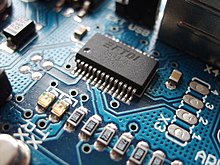Electronics
![]()
The title of this article is ambiguous. For other meanings, see Electronics (disambiguation).
Electronics is a major field of electrical engineering. It is the science of controlling electric current through electronic circuits, that is, circuits in which at least one component operates by virtue of vacuum or semiconductor conduction. Electronic elements behave nonlinearly, while the behavior of other electrical (non-electronic) elements is called linear. Electronics is also concerned with the function of electronic components themselves. Electronic components and circuits at smaller scales is named according to the structure sizes with SI decimal prefixes, e.g. microelectronics (typically <100 microns) or nanoelectronics (typically <100 nanometers), which is usually realized with the integrated circuit e.g. silicon chip.
Electronics processes electrical signals in terms of information or generates them, or transforms electrical energy in terms of its voltage-current ratio with the aid of amplifiers or rectifiers.
Electronic circuits are usually assembled on circuit boards with the aid of printed circuit board assembly and either assembled as modules to form electronic devices, or they become part of electrotechnical apparatus.
Optoelectronics is a branch of electronics and deals with the control by light.

Surface of an electronic board (Arduino ftdi chip-1)

Electronics for controlling a motor speed (HitachiJ100A)
Word formation
The term electronics is derived from the Greek word elektron (ήλεκτρον), which means amber. Electronics is a portmanteau word put together from the terms electron (the elementary particle) and technology. Electronics, so to speak, is electron engineering.
History
In 1873, Willoughby Smith discovered that selenium is capable of conducting when exposed to light (photoelectric effect). Following this discovery, Karl Ferdinand Braun discovered the rectifier effect in 1874. Stoney and Helmholtz coined the term electron as the carrier of electric current. In 1883, Thomas Alva Edison received a patent for a DC voltage regulator based on incandescent emission (the Edison-Richardson effect), a prerequisite for all vacuum tubes. In 1897, development of the Brauntube began by Karl Ferdinand Braun. This was followed in 1899 by the development of the peak diode. In 1904, John Ambrose Fleming obtained a patent for a vacuum diode.
See also: History of the electron tube
At the beginning of the 20th century, the development of electron tubes was already advanced. The first electron tubes were developed and already used in electrical circuits. With the triode, for the first time a usable component was available for the construction of amplifiers. This made inventions such as radio, television and radar possible.
In 1948, the first transistor was introduced. Like tubes, transistors can be used as amplifiers, electronic switches or as oscillators. However, unlike vacuum tubes, which require a lot of space and electrical power, transistors can be manufactured very small, because they are based on semiconductor technology, which allows much higher current densities.
In the 1960s, the production of complete circuits consisting of several transistors and other components on a single silicon crystal was achieved. The technology of integrated circuits (IC for short), which was introduced as a result, has led to constant miniaturisation since then. Today, semiconductor electronics is the most important branch of electronics.
Polytronics is sometimes seen as a key technology for the future. It refers to the combination of plastic-based system functions to create the vision of "intelligent plastics".
Questions and Answers
Q: What is electronics?
A: Electronics is the study of electricity (the flow of electrons) and how to use that to build things like computers. It uses circuits made with components and connecting wires to do useful things.
Q: What science underlies electronics?
A: The science behind Electronics comes from the study of physics and gets applied in real-life ways through the field of electrical engineering.
Q: What are some examples of electronic components?
A: Examples of electronic components include transistors, fuses, circuit breakers, batteries, motors, transformers, LEDs and bulbs.
Q: How can an electronic system be broken down into parts?
A: An electronic system can be broken down into three parts - inputs, signal processing circuits and outputs. Inputs are electrical or mechanical sensors which take signals from the physical world and convert them into electric current and voltage signals. Signal processing circuits consist of electronic components connected together to manipulate, interpret and transform the information contained in the signals. Outputs are actutators or other devices that transform current and voltage signals back into human readable information.
Q: How does a television set work?
A: A television set has as its input a broadcast signal received from an antenna or cable for cable television. Signal processing circuits inside the television set use the brightness, colour, and sound information contained in the received signal to control its output devices such as a cathode ray tube (CRT), plasma or liquid crystal display screen for display output device; magnetically driven audio speaker for audio output device; etc., which convert these signals into visible images displayed on a screen or sounds heard by listeners respectively.
Q: What is analysis of a circuit/network?
A: Analysis of a circuit/network involves knowing both its input and signal processing circuit in order to find out what its output is going to be.
Q: What is synthesis when it comes to electronics?
A: Synthesis involves knowing both input and output then finding out or designing what kind of signal processing part will be needed in order for it all to work together properly
Search within the encyclopedia